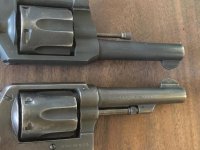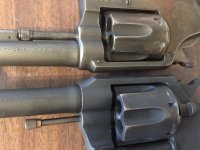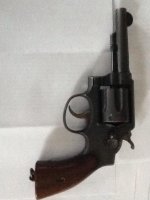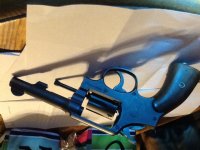Most people tend to use "parkerizing" as a generic term for any kind of dullish utility finish the way we use kleenex for any disposable nosewipe regardless of the actual manufacturer. As DWalt's summary makes clear, in this case that is not precise enough and can lead to confusion and/or misidentification of an original or re-finish.
For illustrative purposes, and since I just had them out of the safe, I've attached a couple of photos for comparison. Comparing Victory finishes with Colt's equivalent, the Commando, a utility version of the Colt Official Police, is instructive; on the Colt contract, the Army actually specified the finish as Parco-Lubrite, the trade name registered in 1940 by the Parker Rust Proof Company. So Commandos are actually parkerized in the real sense of the word.
The two guns pictured are in about the same state of preservation, good original finish with only moderate holster wear at the muzzle and frontal edges. The Commando is from late 1943, the Victory from mid-1944.
While the lighting isn't perfect, it's the contrast that's the point here. Compare the standard dull black of the parkerizing to the lighter, more greyish and sometimes even greenish sheen of the Victory. This occasionally leads less knowledgable people to mistake a Victory's finish for patina. Conversely, if you see a flat black-grey parkerized Victory in excellent condition, it could very well be a re-finish. So look closely. Especially a lot of Australian and NZ ex-BSR's have come back to this country re-parkerized.
If you're observant, you'll notice that the hammer on the Commando is also parkerized. That's original; in contrast to S&W, which left hammer and trigger case-hardened, Colt finished both like the rest of the gun.







